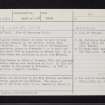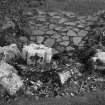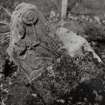Scone Abbey
Abbey (Medieval), Architectural Fragment(S) (Medieval), Priory (Medieval)
Site Name Scone Abbey
Classification Abbey (Medieval), Architectural Fragment(S) (Medieval), Priory (Medieval)
Alternative Name(s) New Scone; Scone Park; Scone Palace Policies; Scone Priory
Canmore ID 28192
Site Number NO12NW 9.03
NGR NO 1169 2649
Datum OSGB36 - NGR
Permalink http://canmore.org.uk/site/28192
- Council Perth And Kinross
- Parish Scone
- Former Region Tayside
- Former District Perth And Kinross
- Former County Perthshire
Notes on the medieval town of Scone - These notes were prepared from an examination of the post-reformation feus of abbey property within and adjacent to the town of Scone, in conjunction with other sources readily available to the author. The research was carried out in Northampton, using sources to hand, and usefully demonstrates the need for more documentary research in the archaeological evaluation of heritage sites in Scotland.
The research provided the following insight into the town or Royal City of Scone, Scone Abbey and other related heritage:
1. That in the 16th century the town lay south and north of the Catmore Burn, and south of the designated location of the Royal City/ancient village.
2. In consequence, the town shown on the Roy's Military Survey 1747-55 and in Slezer's view of the house and town c.1698, probably represents a 17th century remodelling of the town in conjunction with the layout of Scone Palace.
3. There was a parish church 1599-1624, which is described in Post Reformation documents, and this probably stood in the graveyard east of the palace.
4. That Scone Abbey most probably stood south of Scone Palace, towards Friars Den.
Dr Thomas C. Welsh 2007.
NO12NW 9.3 1150 2647.
(NO 1150 2647) Site of Monastery (NR)
OS 6"map, Perthshire, 2nd ed., (1900)
For moulded finial (possibly from Scone Abbey) which is at Waterybutts farmhouse, Errol (NO 2750 2587), see NO22NE 7.02. For fragment of tracery (probably from Scone Abbey) found at Charlestown, Errol (NO 2450 2761), see NO22NW 42.01.
The religious establishment at Scone is said to have been originally occupied by the Culdees, though this cannot be verified ... The exact date of the foundation of the Augustinian priory by Alexander I is in doubt but was probably about 1120 as suggested by Barrow (Barrow 1953) It is probable that Scone was colonised by monks from Nostell, Yorkshire.
The priory became an abbey in December 1164, the previous church probably having been destroyed by fire. In 1559 the abbey was burned to the ground by Reformers. In 1581 it was erected into a temporal lordship.
D E Easson 1957; Barrow 1953.
Scone Abbey was dedicated to the Holy Trinity and Saints Mary, Laurence, Augustine and Michael. The stone of Destiny lay in the Abbey until it was removed by Edward I.
M Walcott 1874
'About 100 yards due east from the south east corner of the house (i.e. the house built about 1604, not the present Scone Palace built 1803-8) are vestiges of the old abbey church.
Between 60 or 70 yards north from this place is what is vulgarly called the Boothill'.
The remains of the abbey church fell about 1624.
'The abbey wall, from the foundations which have been dug up, is supposed to have inclosed a space of 12 acres.'
Statistical Account (OSA, written by R Thomas) 1796.
In 1841, the workmen came upon what may have been the foundations of the monastery. One apartment which seemed to be a sort of cell, was found in pretty good repair. It was surrounded by stone seats about 15 inches broad and might have measured ten to twelve feet.
Near the 'Chanter Gate' are some trees that are said to have stood in the garden of the monastery. Among them were remains of a wall.
NSA (written by J Craik, 1843) 1845.
Field Visit (16 October 1963)
No further information was found regarding the site of this Monastery or of the possible foundations of it found in 1841 (NSA 1845) (information from Mr Adams, Estate Factor) The remains of a wall among some trees (NSA 1845) were not located.
Visited by OS (WDJ) 16 October 1963.
Field Visit (March 1990)
In 1114 x 15 Alexander I founded an Augustinian priory at Scone. The dedication of the church to the Trinity has been taken to suggest that there was already a Culdee church at Scone, but this is unverified. In 1164 the priory was elevated to the status of an abbey, within which the 'Stone of Destiny' is said to have been kept until its removal in 1291 by Edward I.
Although no structural remains of the priory church or abbey survive, it is believed that the church probably stood to the S of Boot Hill and W of the present graveyard (NO12NW 9.02 and 9.15, respectively), and that the monastic cemetery (unless covering two separate areas) probably lay between the priory church and Boot Hill. This appears to be confirmed by the author of the Statistical Account who notes 'the vestiges of the old abbey church' about '100 yards due east from the south east corner of the house'. Similarly, the author of the New Statistical Account notes the discovery, in 1841-5, 'between the present palace and the church-yard' of part of the cemetery (NO12NW 9.04). It is also recorded, whilst making alterations to the garden terraces to the S of the present graveyard (NO12NW 9.15), that workmen came upon 'what may have been the foundations of the monastery. One apartment, which seemed to be a sort of cell... was surrounded by stone seats, about 15 inches broad, and might be from 10 feet to 12 feet in dimension'.
In 1559, both the abbey and palace are said to have been burnt by the Reformers, but no parish church comes on record until 1624. This new church is thought to have stood on the Boot Hill (NO12NW 9.02) but the topography of the present graveyard (NO12NW 9.15), together with the disposition of 17th- and 18th-century gravestones, suggests that this area, too, is the site of a church. It is likely that this is the abbey church (part of which may have remained in use between 1559 and 1624) and that the conventual buildings lay to the S, accounting for the discovery of structural remains in the garden terrace on the S side of the graveyard.
Architectural fragments from the abbey are grouped at various points around the policies (NO 1164 2649, 1164 2652, 1165 2655 and 1169 2649). These include a very fine Romanesque cubic capital (probably from a door or window of the earlier priory church which was burnt in 1166), a double-cap (of 12th- or 13th-century date, probably from the cloister arcade), and fragments of tracery mullions, vaulting bosses, and arch- and rib-mouldings of 13th- to 14th-century date, together with a stone sarcophagus and the inscribed cover-slab of Abbot Mar (NO12NW 9.04). Other mouldings and masonry fragments are incorporated into the gateway (NO12NW 9.07) and precinct walls on the N drive (at NO 1155 2664), while some have travelled further afield (for which, see NO22NW 42.01). According to the Statistical Account, the pattern of chance discovery of foundation-stones has indicated that the abbey precincts enclosed an area of 12 acres (4.8ha).
Visited by RCAHMS (IMS) March 1990.
Liber ecclesiae de Scone; Statistical Account (OSA); New Statistical Account (NSA); W F Skene 1871.
































